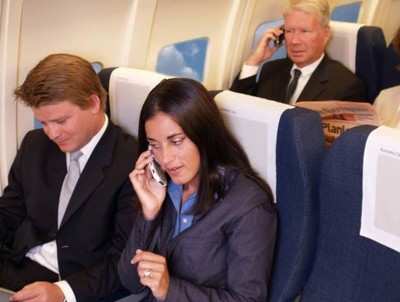Tue, Sep 14, 2004
At 35,000 Feet
Nearly half of all international business fliers would prefer to
travel on airlines that allow the use of mobile phones in flight.
That is the emphatic conclusion from a survey of 1,200
international business and leisure travelers at two of the
world’s busiest airports—London Heathrow and Gatwick.
The research was conducted for Telenor and ARINC.

The companies are marketing an inflight GSM mobile phone service
for passengers—ARINC-Telenor Mobile Connectivity. They plan
to demonstrate their system at the World Airline Entertainment
Association (WAEA) in Seattle (WA) Sept. 21-24.
"Our research shows a pent-up passenger demand for in-flight
mobile service," said ARINC Vice President Graham Lake. "Fully 83%
of business fliers now carry their mobile phones in flight, while
about half carry a laptop computer. The world today has more than
1.5 billion mobile phone subscribers, with almost 75% using GSM
technology."
Many planes could be readily equipped with the ARINC-Telenor
service because more than 1,900 already have the classic Inmarsat
hardware needed. ARINC and Telenor are offering airlines a
comprehensive, one-stop implementation package.
The technology allows passengers to use personal GSM mobile
phones in flight just as on the ground—and without any
enrollments, sign-ups, credit cards, or dialing of extra digits.
The system treats the world’s airspace just like calling
another country. Passengers are charged a reasonable fee, similar
to international roaming rates on the ground. Calls are
transparently billed to passengers’ mobile accounts by their
own cellular providers.

"Passengers can roam onto this system as easily as visiting a
new country. They can make calls, accept incoming calls, and send
or receive text messages," said Berit Svendsen, chief technical
officer for Telenor. "Close to a third of business passengers found
this concept very appealing, and as much as 28% of all passengers
were willing to pay as much as three to six dollars per minute for
inflight mobile service. More than half of all respondents would
send and receive text messages as well."
The research was conducted in June-July 2004 by IMDC (Inflight
Management Development Center), an independent UK-based company
that specializes in management support services for the in-flight
business sector.
More News
He Attempted To Restart The Engine Three Times. On The Third Restart Attempt, He Noticed That Flames Were Coming Out From The Right Wing Near The Fuel Cap Analysis: The pilot repor>[...]
Make Sure You NEVER Miss A New Story From Aero-News Network Do you ever feel like you never see posts from a certain person or page on Facebook or Instagram? Here’s how you c>[...]
From 2009 (YouTube Edition): Leading Air Show Performers Give Their Best Advice for Newcomers On December 6th through December 9th, the Paris Las Vegas Hotel hosted over 1,500 air >[...]
Aero Linx: NASA ASRS ASRS captures confidential reports, analyzes the resulting aviation safety data, and disseminates vital information to the aviation community. The ASRS is an i>[...]
“For our inaugural Pylon Racing Seminar in Roswell, we were thrilled to certify 60 pilots across our six closed-course pylon race classes. Not only did this year’s PRS >[...]
 NTSB Final Report: Rutan Long-EZ
NTSB Final Report: Rutan Long-EZ ANN FAQ: Turn On Post Notifications
ANN FAQ: Turn On Post Notifications Classic Aero-TV: ICAS Perspectives - Advice for New Air Show Performers
Classic Aero-TV: ICAS Perspectives - Advice for New Air Show Performers ANN's Daily Aero-Linx (06.28.25)
ANN's Daily Aero-Linx (06.28.25) Aero-News: Quote of the Day (06.28.25)
Aero-News: Quote of the Day (06.28.25)



